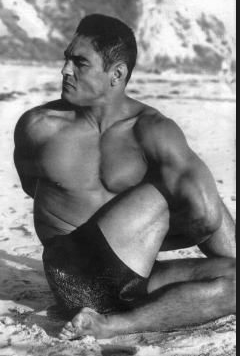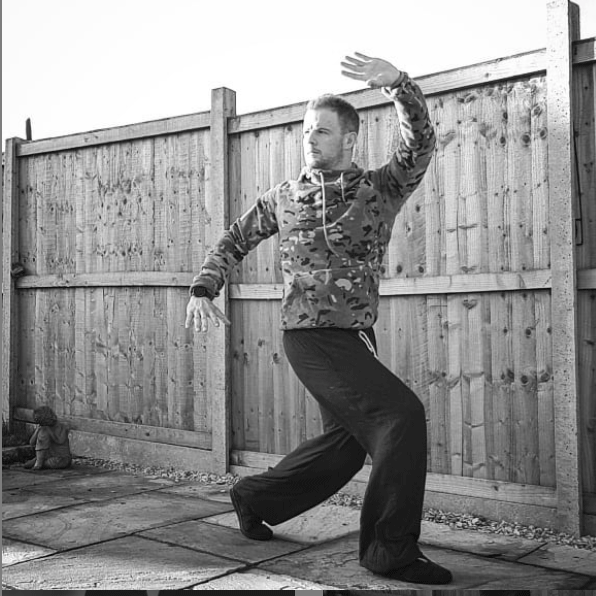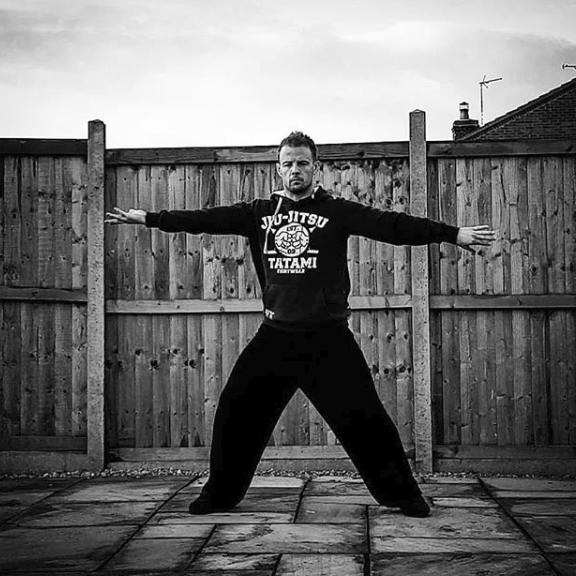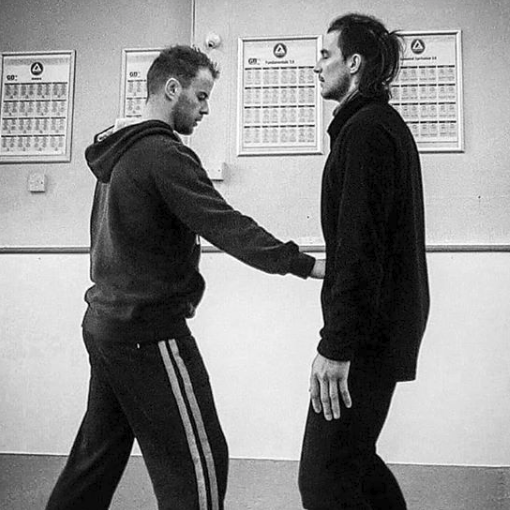For over 20 years now I have been immersed in training for the creation of the MartialBody. Until I crystallised the process of attribute training, this work was done under many other names, Nei Gong, Jibengong, Tanren, Tenko-no-Jutsu to name but a few. But regardless of the label placed on the methods one undeniable fact remained about these methods, the work is largely done alone.
In the martial arts there is often a focus on training with the partner. Of course, to be an effective fighter it is unavoidable that we need to work with someone. But what is often pushed into the background is the importance of solo training. This is a mistake as, ultimately, how we apply our martial art with partners or opponents is entirely based on how we control and move our own bodies.
Solo training as a core
 Virtually every highly skilled martial artist that I have encountered had training methods where they turned their focus on themselves. This self-focus can take many forms, be that the MMA or BJJ athlete working on their strength or Conditioning, the Iaido exponent performing Suburi with a heavy Oak Bokken or the I Chuan Exponent standing still for long periods of time. Regardless of method, most martial artists that are serious about their progression will be working hard on their own, away from the regular classes.
Virtually every highly skilled martial artist that I have encountered had training methods where they turned their focus on themselves. This self-focus can take many forms, be that the MMA or BJJ athlete working on their strength or Conditioning, the Iaido exponent performing Suburi with a heavy Oak Bokken or the I Chuan Exponent standing still for long periods of time. Regardless of method, most martial artists that are serious about their progression will be working hard on their own, away from the regular classes.
However, in my experience it would also be true to state that there is a huge volume of people who only train in the Dojo or Gym and who rely on the practice in these places to hone their skills. In fact, there are also a few Elite level individuals who do the same but, in my experience, these individuals are outliers. They are rare individuals for whom a combination of genetics, mind and natural ability combine to produce high skill and body development levels without the need for lots of additional solo training. With that said, when you really dig in, you do find that they are doing ‘something’ outside of the normal gym environment.
But for most of us mere mortals, it is a reality that solo training, either at home or at some other place away from the Dojo is a must. Simply look at some of the true greats like Rickson Gracie and you will see that much of their training time was spend on solo methods. In his case this took the form of Yoga & Breath training.
Many people in their early stages of training don’t realise the importance of solo work. They will begin a martial art, be content to turn up a few times a week and get the most out of those sessions. The assumption for many of the new martial artists is that the highly skilled peers in the group got there by training the ‘techniques’ that are being taught in the class. But often this is not the case. Often those who are pulling ahead are putting in a huge amount of time outside of the dojo.
 The Challenges of solo training.
The Challenges of solo training.
Dedicating to training on your own will present many common ‘obstacles’ but knowledge is power, and habits are created soon enough. Here I will outline some of the most common challenges that solo training presents and how they can be overcome. It is extremely important to understand that you are not alone in these challenges, you are not the first to experience them and will not be the last. Indeed, every student I have taught has encountered these challenges when dedicating themselves to training alone.
The challenge of time
“I don’t know how I will fit it in!” or “I don’t have the time!”.
How often have you said this to yourself when considering how you will train at home or on your own? I know I have! But often this first challenge is an illusion created by your own expectation of training. Many people, when they first begin, believe that they MUST train every day for an hour or 2 to get anything from their training time. People are in a rush. They talk to their peers who will say things like “I train 3 hours every day”. Hearing this they will take it to heart and form the opinion that training for 20 minutes every other day simply won’t cut it! This is the first assumption to get over.
Firstly, let me be the first to tell you that your peers are probably stretching the truth a little when it comes to how much they train. But much more importantly, you are not them so put their training schedule completely out of your mind. There is no doubt that ‘some training’ is better than ‘no training’. Personally, I have had some of my biggest breakthroughs in the theory of what I was doing when stood waiting for a Kettle to boil, or when stood in the garden for 5 minutes and performing one movement.
You have the time. You just don’t know that you do. It really is that simple. So, let yourself off the idea that you need to dedicate many hours a day to solo work. Just start, and soon enough, things will start to happen.
The Challenge of Will Power
But for many people available time is not the real obstacle even if it is sighted as the excuse. In fact it is the willpower to start the journey in the first place. To go from little to no training to ‘some training’ requires willpower, a resource that is often overlooked but often tested.
 Whether it comes to getting up that hour early, leaving the phone or TV alone for 20 minutes or simply practicing a stance while the Kettle is boiling, every action that we take that takes our body out of its current comfortable state requires willpower.
Whether it comes to getting up that hour early, leaving the phone or TV alone for 20 minutes or simply practicing a stance while the Kettle is boiling, every action that we take that takes our body out of its current comfortable state requires willpower.
Firstly, we must understand that for many of us willpower is a finite resource and if you exhaust it, then you will simply not have any left for a given, extra, task like solo training. I can’t tell you how many times I have taught individuals who go away with grand plans to “train every day” to “devote myself to this work” who, after a week, have stopped training on their own (Even though they continue to pretend they do!). That initial fire for the methods has been extinguished by unrealistic tests of their willpower.
But the good news is that after a relatively short period of time, between 15 – 30 days, a task which requires willpower will transform into something quite different, a habit. Often, I am asked how I dedicate so much time to training every day. People say I must be extra motivated or have amazing discipline, when really the fact is that I have simple created habits that are harder to break than to continue. And the creation of those habits was a gradual and progressive process.
The transformation of tasks that require willpower into habits is the key to those struggling to dedicate to the training time. But you must start carefully, usually with one small change, make it something very easy for you to do. After it is a habit and you do it without any need to test your willpower, then you change it or add to it slightly. Make the habit again and repeat. Soon enough you will likely find yourself training for productive periods without any need for willpower at all.
The Challenge of information
But with all the time in the world and the right habits in place there is still one big problem. What to work on?! This was a problem that I encountered early on in my training of the Internal Chinese Martial Arts. I would visit teacher on weekends and walk away with, literally, years’ worth of information. After 6 months of doing this I realised that training everything I was learning, actually meant I was training nothing! I was spending hours every day re-capping and covering every Jibengong method, every Nei gong method, every form, every variation, every movement, but was only training each thing for maybe 5 minutes.
 With this realisation the next time I saw my teacher I asked him “Please can you just show me the most basic things for me to train … the few things that make all the difference”. He smiled and told me I was only the second person to ask him that question and for the following session at a seminar, while everyone else was learning 4 of the 8 Ba Gua palm changes and all their intricacies I was drilling 1 movement … just 1. I found this greatly ironic, people in the seminar thought they were getting their moneys worth, but really they could have just been shown one step, or one body movement for 6 hours and gained far more.
With this realisation the next time I saw my teacher I asked him “Please can you just show me the most basic things for me to train … the few things that make all the difference”. He smiled and told me I was only the second person to ask him that question and for the following session at a seminar, while everyone else was learning 4 of the 8 Ba Gua palm changes and all their intricacies I was drilling 1 movement … just 1. I found this greatly ironic, people in the seminar thought they were getting their moneys worth, but really they could have just been shown one step, or one body movement for 6 hours and gained far more.
This hints at a very real problem that I faced in designing my MartialBody foundations courses. In the modern world, we value ‘Volume’ of information more than we value ‘Quality’ of information. Indeed, I could have made each of the Foundations courses about 1 hour long, and very few techniques and, if people simply went away and trained, they would get the results. However, the benefit with the higher volume of material is that it gives us an opportunity to precisely select methods that most appropriately train towards our goals.
With that said, for many training MartialBody especially those with all of the foundations courses, they now fact a mountain of information … enough information to train for the rest of their lives! I myself am still training these foundations and finding new things! But the upshot is that many training MartialBody or other solo training methodologies find themselves in the same position that I found myself in in the Internal Arts, drowning in information.
I was extremely lucky when training, because my teacher had himself, been through extended periods of training very few things. But for most people, who are responsible for their own training design it is not so easy. I have thought long and hard about how to pick what to work on and where to place your focus and my conclusion is that, ironically, more knowledge is power.
However, this isn’t more knowledge of techniques, concepts, principles, anatomy or other such things. It is instead knowledge of your journey, where you are right now, where you want to be, and what it takes to get there. This type of planning is truly invaluable.
The biggest hurdle is to identify a long term, over aching goal. Why are you training? A difficult question to answer for some. But, once that larger goal is identified, the next step is to gain an honest appraisal of your current level of development (there are tools for this in the MartialBody Private Training Service) so that you have a crystal-clear impression of where you are starting from. This provides you with a rudimentary map of what you need to start working on, it will identify short term training goals, which will highlight which methods you need to use, and then you are off to the races!
The Challenge of progress
So, you are dedicating time to training, and are using methods to develop towards a specified long-term goal. That’s great! But how do you know when you are progressing? Again, this point can prove a challenge and has seen the downfall of many a practitioner.
 With some body development training the advancement is easy to see, you lose bodyfat and gain muscle. But with Attribute training the changes are much less easy to identify, especially in the short term. Training HeavyBody for 6 months won’t make the scales change when you step on them for instance. So how can you best measure the effectiveness of your solo training methods and progress towards your goals?
With some body development training the advancement is easy to see, you lose bodyfat and gain muscle. But with Attribute training the changes are much less easy to identify, especially in the short term. Training HeavyBody for 6 months won’t make the scales change when you step on them for instance. So how can you best measure the effectiveness of your solo training methods and progress towards your goals?
Well firstly, I recommend private students to purchase a diary and write a few notes on every training session. Starting with a simple assessment of the body and mind prior to a given training session and then a short assessment after the training. This shouldn’t be an essay as that requires more willpower … which we have already highlighted above. It should be some basic notes, how you feel, any aches and pains, your mental state before you start training. Then how the body or mind has changed at the end of the training.
Every month, you will look at your training diary and assess if anything has changed from day one to day 30. With the ink in front of you reminding you how things were in the early stages of training, it is easy to see progress. Most people simply forget the challenges that they may have faced in those earlier days and being reminded of how far you have come is a powerful tool.
Additionally, this process of recording your training makes you better able to adjust things if the training is not baring the desired fruit. You can ‘tweek’ your plan if results are not progressing as originally envisaged. This tweeking and assessment is a highly successful way of progressing. Indeed it is a far superior method to the ‘Just Train’ approach in my experience.
Secondly, because much of the effect of training is in how it is felt by a partner, you should be engaging with regular training partners at every opportunity. Other people are highly sensitive to changes in the way you ‘move’ and ‘feel’, especially if they have trained with you for a long time. Comments like ‘You are getting strong’ will point to successes from solo training that may be hard for you to perceive via other methods.
Conclusion
The commitment to solo training can be a lonely road, where you must take personal responsibility and get on with things without the expert guidance of a teacher in front of you. But the pay offs are huge and proven. The majority of the great names in the martial arts have dedicated time to training on their own, to building attributes that they could then deploy against opponents. I hope this article is useful. Especially for those with a tendency to collect information but haven’t yet committed time to the training. There is nothing standing in your way, and tomorrow is as good a day as any to take a step in the right direction!